The US scientists have developed a new vaccine against coronavirus based on the receptor-binding (RBD) domain of the S-protein SARS-CoV-2 and, in studies on mice, have selected the most effective adjuvants for it – aluminum hydroxide and CpG protein.
According to material published in the journal Science Translational Medicine, the new drug has shown efficacy similar to mRNA vaccines and is intended primarily for the elderly.
RBD is a key target of SARS-CoV-2 vaccines, but RBD itself is weakly immunogenic. This is why (other vaccines) have used total S-protein, which is more difficult to mass produce, ”explains lead author David Dowling of Harvard Medical School.
In order to find the best adjuvants – substances that enhance the effect of vaccines – the researchers tested various combinations of them with the vaccine on young mice. The rodents were given two doses and their humoral – antibody-linked – immune response was measured.
Aluminum hydroxide is the most common adjuvant in the world and helps the vaccine antigens stay in the body longer. CpG is known to stimulate Toll-like receptors in the innate immune system, thereby eliciting a stronger immune response.
In experiments, the mixture activated an innate immune response in the leukocytes of older people, similar to that of younger people. After administration of the mixture to mice, a high titer of neutralizing antibodies was recorded in all age groups. The adjuvant vaccine completely protected 14 months old mice from SARS-CoV-2 infection. The developers emphasize that their drug – unlike mRNA vaccines – does not need a cold chain.

